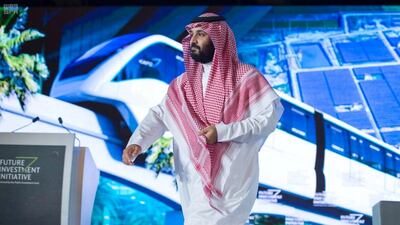In October, Saudi Arabia announced its latest mega project, Neom, a US$500 billion city that could transform the economy and culture of the kingdom's Red Sea coast. Like other Arabian Gulf countries, most notably the UAE, Saudi Arabia has an affinity for reforming its economy with high-profile mega projects, far removed from the mundane nature of state-led economic activity in western economies. What accounts for this Gulf idiosyncrasy?
One reason is clear: media attention. The Gulf states are fortunate to be endowed with some of the largest petroleum reserves in the world, but they are also extremely poor in some of the more conventional pillars of a modern economy, most notably arable land and the water that is required to work it.
That means that creating non-oil economic activity is a considerable challenge.
As countries such as Bahrain and the UAE have, since the 1970s, demonstrated that a logical alternative source of economic activity is foreign direct investment (FDI).
However, for foreign capital to come to the Gulf, it first has to be aware of the opportunities. This is where media exposure plays a role, and is a key reason why the UAE's Government regards Expo 2020 Dubai as contributing to the country's economic future, rather than simply being a celebration of the nation's past achievements.
Therefore, to some extent, Saudi Arabia's Crown Prince Mohammed bin Salman's decision to present a group of infrastructure investments as a headline-grabbing mega-project helps increase the inward flow of capital both for Neom and for other components of the nation's Vision 2030.
But that’s not the whole story. Less clear – but still of huge importance – is the use of mega projects as a way of overcoming internal opposition to certain types of reform. To understand this point, it’s useful to consider the case of charter cities.
________________
Read more:
Crown prince Mohammed details astonishing plans for $500bn NEOM mega-city
IMF backs Saudi $500bn mega-city project
________________
Around 10 years ago, American economist Paul Romer, who has become the chief economist at the World Bank, began championing the idea of founding new, independent cities, on land donated by governments, and with infrastructure built from scratch using private capital.
The most important feature is that the laws could be written from zero, without any input from governments.
The chief attraction of such a setup is that it allows the new administration to overcome the legal and regulatory sclerosis that impedes economic growth in virtually every country.
A combination of bureaucratic sluggishness and entrenched interests mean that across the globe, lawmakers find it very difficult to make fundamental changes to the legal system – witness the opposition that French president Emmanuel Macron is facing as he tries to reform the labour market, or the struggle by several US presidents over the years to reform firearms laws.
Not every system is capable of reforming itself, and sometimes it is better to “blow it up” and start from zero, which is the founding principle of charter cities.
A key difference between the public and private sectors, however, is that an underperforming company will shrink and eventually go bankrupt if it fails to reform.
In contrast, ineffective public sector organisations can persist and even grow despite their failings, because they often do not generate conventional revenues and bottom lines, nor are they exposed to competition in a market.
Seen through this lens, Gulf mega projects can be thought of as watered-down versions of charter cities.
If the government wants to enact bold reforms, the existing system will present many barriers, most saliently from those who have fashioned pockets of power at the expense of the general interest, and perceive the proposed reforms as a threat to their pseudo-fiefdoms.
For example, suppose that a cutting-edge economic activity requires a licence from a specific ministry, and that getting the licence is so slow and costly under the prevailing set-up that most investors do not bother. The relevant minister will almost certainly refuse any attempt to cancel the licensing requirement, since it is a source of influence. The head of state can override the minister, but that is an exceptional recourse, rather than the systematic one that makes investors comfortable. Therefore, an effective alternative is to make a jurisdiction that plays by a different set of transparent rules. This is the thinking behind some Gulf mega projects, as well as the free enterprise zones that contributed to China’s economic miracle.
Why do the Gulf countries use such a tactic more than conventionally-structured economies? Because in countries such as the UAE, the public sector controls an unusually large percentage of the economy’s resources, because oil revenues accrue to the state. Consequently, the government plays the role of chief investor and project manager for the lion’s share of economic activity, creating an increased need for effective, state-led economic ventures.
Ironically, therefore, a key indicator of the success of Gulf mega projects will be a gradual diminution of their incidence, since the primary goal of the economic visions is the transformation of the private sector into the economy’s main driver. Hopefully, Neom will be the last mega project that the Saudi economy needs.
Omar Al-Ubaydli is a researcher at Derasat, Bahrain. We welcome economics questions from our readers via email (omar@omar.ec) or tweet (@omareconomics)


